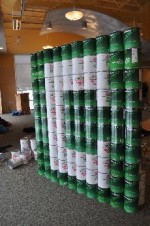Students ‘Canstruct’ sculptures for the hungry

When the word “sculpture” comes to mind, many might imagine Michelangelo’s famous “David” or “The Thinker,” by Auguste Rodin. Some probably also think of the most common medium, clay, because popular sculptures rarely sway from using alternative material to create elaborate sculptures and even fewer impact society on a community level. Until recently.
Since 1992, an organization called “Canstruction” has been challenging businesses, architects, and even students to design and construct large sculptures from canned goods. From building football stadiums to telephones, groups put their creativity to the test making large, elaborate three-dimensional models from nothing but cans and nonperishable food items.
Since its beginnings, Canstruction has donated more than 15 million pounds of food with its alternative can drive. The Canstruction competitions are usually held in big cities, with New York City hosting the first. But women and gender studies Professor Melinda Mills had the bright idea to bring this big challenge to our small state.
“I went on a visit to New York City and stumbled upon an ad describing Canstruction. I had to check it out,” said Mills. “When seeing it up close, I thought it was such a neat idea.”
Mills decided she wanted to bring the same challenge to Castleton and her classes. Each class is divided into about four to five teams. Each group focuses on acquiring cans for one specific part of a certain design.
Mills’ student, Chelsea Rudenis, revealed that her group was in charge of constructing a tail.
“I was in NHS in high school and we did a lot of food baskets for our town. This is something different. It’s going to be kind of cool to see how this turns out,” Rudenis said.
Mills believes the project will have numerous positive impacts.
“It’s affecting real people and it’s nice to share the lesson with your students that it’s important to help out when you can,” said Mills excitedly.
Mills has partnered with five different food pantries in the Castleton area including the Castleton Food Shelf. Lois Ladd, director of the food shelf, was ecstatic when she received the call about a possible large donation.
“We always need food and the fact that the college is willing to help out is just super,” said Ladd with a sparkling tone.
The tone, however, quickly became serious. Ladd sighed and said, “We used to have enough supply to share with West Rutland, but with the way the economy is now it’s hard to keep up with the demand.”
With food shelves preparing for donations and small, descriptive flyers being posted over campus, the word has spread about the creative challenge.
“It’s really cool to see the energy and curiosity surrounding the event. I’m not hoping for miracles in the first year,” Mills mentioned, “But we’re focusing on being recognized. Hopefully the popularity snowballs.”
The finished “canstructions” will be viewable from March 7-9 in the 1787 room in the Campus Center. When asked what designs would be featured, Mills chuckled and said, “Well, there’s various local Vermont themes and collegiate themes related to Castleton, but I don’t want to give anything away. You’ll just have to come see.”
Mills said food and monetary donations can continue throughout March, even after the sculptures are taken down and donated.




